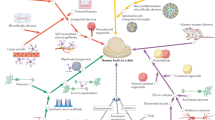Summary.
The present study was undertaken in order to analyse the possibility of culturing post mortem derived human fibroblasts. The combination of post mortem fibroblasts with the autopsy proven and histopathologically staged brain will allow the correlative investigation of dynamic biochemical processes which are systemically underlying or accompanying a neurological and/or psychiatric disorder. These studies are limited in autopsy brain or are uncertain when the neuropathological status is lacking, i.e. when fibroblasts were obtained from living patients. Our examinations of human autopsy fibroblast and those under experimentally controlled post mortem conditions with rats clearly demonstrate that autopsy-derived fibroblasts can be reliably cultured. The cells grown displayed typical morphological and staining characteristics as well as pharmacological responsiveness. Even cells obtained from a 99 years old individual or an individual with a post mortem delay of 48 hours grew in our culture system.
Similar content being viewed by others
Author information
Authors and Affiliations
Additional information
Received August 6, 1998; accepted November 16, 1998
Rights and permissions
About this article
Cite this article
Meske, V., Albert, F., Wehser, R. et al. Culture of autopsy-derived fibroblasts as a tool to study systemic alterations in human neurodegenerative disorders such as Alzheimer's disease – methodological investigations. J Neural Transm 106, 537–548 (1999). https://doi.org/10.1007/s007020050177
Issue Date:
DOI: https://doi.org/10.1007/s007020050177




